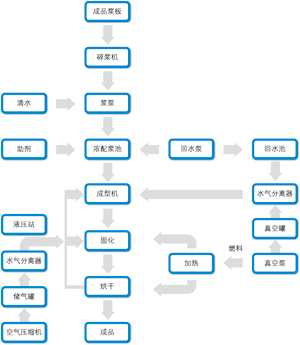As honeycomb composite materials replace timber in furniture manufacturing, the use of wood is greatly saved. Therefore, it has been widely promoted and used in the furniture manufacturing industry, and it can effectively improve the defects of the deformation of the wood-based panel. Taking a plate with a thickness of 20 mm as an example, if a 2.5 mm MDF plate is used to make a honeycomb composite panel, the amount and weight of material is only about 1/4 of that of a solid MDF; however, the cost of the composite plate is only solid About 1/2 of the board, and the composite board has the advantages of light weight, not easily deformed, and convenient transportation. Thus, in Europe, more than 80% of the interior doors are cellular composite doors, and most of the furniture panels above 20 mm thickness are honeycomb composite panels. Honeycomb composite panels are ideal for panel furniture. For example, it can be used for panels, top plates, partitions, floors, door panels, and some trim pieces that are thicker than 18 mm. The thicker plates are more able to show the superiority of the honeycomb materials; the thick plates also have good bending properties, used for tables, coffee tables, TV cabinets and so on. There are even support legs that furniture manufacturers use to make furniture, which shows the breadth of their application.
Pulp molding
Pulp molding overview
Pulp molding is a kind of three-dimensional papermaking technology, which refers to adding a certain amount of chemical additives to the pulp in a molding machine. The fibers are evenly distributed on the surface of the mold by vacuum or pressure, thereby forming a wet paper mold blank, and further dewatering and dehydration. Mold, dry plastic products, made of pulp production technology. Different components of waste paper produced products have different properties. Therefore, according to the use of the products, different waste papers or several waste papers can be used together to obtain better economic benefits and performance. Pulp molded articles may be specially designed to improve the structure of the pulp, or to add materials or surfaces of various compositions during manufacture to achieve the properties and characteristics required for an article or under certain conditions. In addition, the characteristics of the paper mold obtained by adopting different processing methods are different, so changing the processing method or process can improve the performance of the paper mold.
Pulp molding production process
The industrial packaging pulp molding production equipment and structure are substantially the same as the pulp molded tableware. It is vacuum-adsorption forming and drying of the pulp with a die, and then deep processing to make a finer product. The production line is generally composed of two parts: the forming equipment and the drying equipment. Because of the high requirements, the tableware products also need to increase the pressure of the entire shape, and the sterilization and sterilization are not prepared. Paper forming methods can be broadly divided into two types: vacuum-assisted vacuum molding and in-mold grouting. Drying methods can be divided into two types depending on the forming method. Vacuum vacuum adsorption molding outside the mold is generally used outside the mold drying cell drying, in-mold grouting extrusion molding directly in the mold directly heated and dried. The process flow is shown in Figure 3.

With the existing technology level, the thickness of paper-molded products is generally between 1mm-60mm, and the thickness of general products is maintained at about 2.5mm; from the current quality and application of paper-molded packaging products, the maximum load capacity Up to 200kg, bear the shape is not too complex, the weight of the product within 50kg is the best choice for the inner lining packaging; paper mold packaging buffer effect is mainly to use its paper wall in the impact of elastic deformation, so as to slow the cancellation of external forces to achieve of. The elasticity of the paper mold material itself is not high, and it mainly depends on the design of the product's support ribs and the formation of a buffer line cavity. The design of the support ribs plays an important role in the elastic deformation of the paper mold packaging product, that is, the buffering capacity. The basic basis for the support rib design is the shape and use of the product itself.
Compared with disposable foamed polystyrene products, pulp molded products are rich in raw materials, and are non-pollution during production and use. They have light weight, high compressive strength, good cushioning properties, and good recyclability. Sex, so it is widely used in packaging. Its application scope includes packaging of food containers, beverage cup holders, medical equipment, cosmetics, fruit trays, mechanical parts, hardware tools, furniture accessories, handicrafts, electronic products, electrical appliances, communication equipment, and audio equipment. However, the pulp molded articles are easily deformed after being exposed to moisture, and the strength thereof is decreased. If the products are not subjected to special treatment, the appearance level is low.
The “4R+1D' principle, which means low consumption, recyclable, recycled, recycled and degradable green packaging†can better realize the coordinated development between packaging and environmental protection and resource regeneration. Honeycomb paperboard and pulp molding, as two new types of green packaging technology, have achieved rapid development in the packaging industry today with its superior performance. At the same time, new green paper packaging is in international trade and meets the environmental protection requirements of packaging in developed countries. Therefore, the development of green packaging is in line with the development trend of packaging in the world, which is conducive to breaking through the international green trade barriers, and also conducive to achieving a harmonious and unified packaging in terms of its functions and environmental protection.